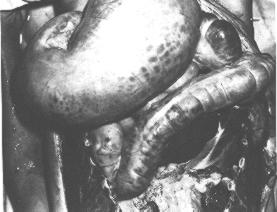
Chagas Disease is prevalent throughout South and Central America. An estimated 15-20 million people are infected and over 100 million people are at risk. In some endemic areas up to 60% of the population is serologically positive for T. cruzi. It was once thought to be an exotic rare disease, but with improved diagnostic methods it is now known to be one of the most widespread infectious diseases in Latin America. In one hospital in Goiania, Brasil, more than 20% of the patients had Chagas Disease. Most cases of sudden death in young adults in parts of Latin America can be attributed to chronic Chagas Disease.
Severe infection with T. cruzi occurs predominantly in children under 10-years old. The course of infection can be classified into three stages: Acute, Indeterminate and Chronic. Chronic Chagas disease occurs many years after the initial infection and the most common aspect of the disease is heart malfunction.
The site of infection develops a localized inflammatory reaction. Usually a subcutaneous nodule develops known as a "chagoma". The swelling is due to the host’s immune response to the parasite: the infiltration of fluids and large numbers of white blood cells (macrophages). This can last 2-3 months and trypanosomes can be aspirated from the nodule. If the infection is on the eye, a unilateral edmea and conjunctivitis develops known as "Romana's sign". Trypanosomes appear in the blood in about 10 days. The acute phase usually occurs with children under 10 years old. Systemic signs appear in 2-3 weeks after infection. There are high fevers, liver and spleen enlargement, muscle pain, rash, acute myocarditis, swollen lympth glands, edema of face, legs or feet, and general malaise (much like the symptoms of an influenza virus infection). There may be CNS involvement.
 |
 |
Prepatent period. Lasts 1-2 weeks and 10-20% of individuals infected with T. cruzi show no symptoms. In as many as 10% of cases, the acute infection may be lethal in a few weeks or months. In survivors, the symptoms disappear and the parasites become dormant inside muscle cells (amastigote nests).
There are no symptoms in this stage, which may last for many years. There are no trypomastigotes in the bloodstream, but antibody (IgG; immunoglobulin G) against T. cruzi is present.
Approximately 10-30% percent of individuals progress from the indeterminate stage to the chronic stage. There are very low levels of parasites in the blood. The adverse effects of chronic Chagas disease include enlargement and aberrant function of the heart, esophagus and large intestine.
Pathogenic mechanisms of T. cruzi infections are not well understood and some complications may be due to toxins, autoimmunity, and body reactions to degenerating parasites. Inflammatory reaction due to GPI anchor, which contains gal and unsaturated fatty acids at the sn-2 position of alkyl acyl glycerolipid. There is further neuronal loss during the chronic phase
The heart (right atrium and both ventricles) may increase to about 3-times its normal size.
Electrocardiogram (ECG) patterns show typical anomalies (arrhythmias and right bundle branch block) that can be diagnostic for Chagas disease. The ventricular arrhythmias are usually responsible for sudden death. Click here for a good review by Elizare and Chiale (1993).
The heart walls can get very thin and may protrude (aneurysm), typically at the apical end. Thrombic emboli can occur.
Mega-Disease
In some patients (varies with the geographical region), there is a dilation of the esophagus or colon resulting in mega-disease. These have severe effects on digestion. Peristalsis is affected by destruction of the ganglion cells by the parasites.
 Enlarged Chagasic heart with aneuism |
 Megacolon at necrospy (Taken from Garcia and Bruckner, Diagnostic Medical Parasitology, ASM press, 3rd ed., 1997) |
 Megaesophagus at necropsy (Taken from Fife, Trypanosoma cruzi, in Parasitic protozoa (ed. J. Kreier), Academic Press, 1977) |
Clinical diagnosis should involve history of travel to endemic regions, recent blood transfusion, reduviid bites. Differential diagnosis involves brucellosis, endocarditis, salmonellosis, schistosomiasis, toxoplasmosis, tuberculosis, connective tissue diseases, leukemia.
Questions:
1. What are the three major stages of Chagas Disease?
2. What is Romana's Sign?
3. What are the pathological events that can appear in chronic Chagasic patients? Why do you think the disease can affect either the heart or the autonomic nervous system in different geographical regions?
4. Why is sudden death often the first symptom of chronic Chagas Disease?